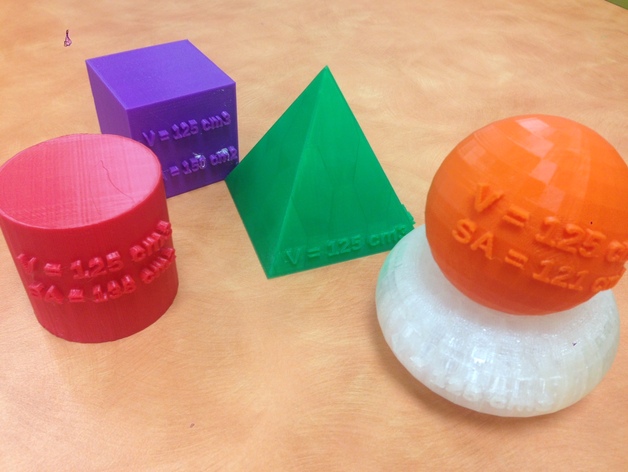
Equal Volume Solids Set + MakerEd Project
thingiverse
This Identical Volume Solids Kit explains why bubbles are spherical, or more precisely, round. The sphere is the shape that uses the smallest surface area to enclose the largest volume! The set contains five solids: a sphere, cube, pyramid, cylinder, and torus, each with a volume of 125 cm3. The surface areas vary from 121 cm2 (sphere) to 168 cm2 (pyramid). Two projects are suggested for use with this kit. One is to challenge students to create a bubble in a shape other than round, using frames or other methods. Another is to challenge students to design another shape with the same volume as the set and then calculate its surface area. Printer Details Printer Brand: MakerBot Print Settings Printer: MakerBot Replicator 2 Rafts: Doesn't Matter Supports: No Resolution: 0.2mm Infill: 5-10% Notes: These models are straightforward to print and each one has been placed to achieve the best resolution on the text. Optional rafts will not interfere with the letters. How I Created This Kit Calculations Using well-known geometry formulas, I calculated the dimensions of various solid shapes that have a volume of 125cm3. Then, using those dimensions, I found the surface area of each solid. Design I used Tinkercad to create blocks of lettering that were angled or curved to match the surfaces of the shapes. Project Idea One - Bubble Challenge Objective: Create a soap bubble with a shape other than spherical. Audience: Kids aged 5 and up, or adults who are also kids at heart! Preparation: Print the Identical Volume Solids Kit. Get some bubble solution ready. You can use a Guar Gum recipe like mine (http://soapbubble.wikia.com/wiki/Recipes_Guar#Recipes) or just get some bubble mixture. Materials: You'll need ordinary bubble wands, like clothesline wire or coat hangers. Print the Equal Volume Solids Set. Add materials for customizing wands and frames - string, straws, pipe cleaners, more wire! Steps Blow bubbles with a round wand. Are they still round(ish)? No! Then try blowing bubbles with different shaped wands (like squares and triangles). Can you see how they turn out? Maybe not exactly square or triangular... Examine the Identical Volume Solids Set. Notice that the sphere encloses the volume using the smallest possible surface area. This is why bubbles are round - their film has to stretch the least, so it can contain a large volume of air. Challenge students to create a bubble in another shape. Go ahead and build frames if you need to hold your bubbles steady! Results: Share what wands and bubble solutions you've got, show how they work! Project Idea Two - Design a Solid Objective: Use geometry skills by creating a solid with a specific volume (125 cm3) and calculate its surface area. Audience: Beginning 3D designers aged about 13 years or older. You could be beginners at geometry as well. Preparation: Print the Identical Volume Solids Set. Find out formulas for volumes and surface areas of solids, or give students the link if they want more resources! Step Explain how to create solid shapes in 3D design using the formulas you used. Show your new skills on designing a solid shape that is exactly 125cm3 but not from our Identical Volume Solids Set! (That would be challenging, I suppose) Optional Extra for advanced students: group together several shapes and try and find their volume using basic calculations. Print out or look over the work that everyone does!
With this file you will be able to print Equal Volume Solids Set + MakerEd Project with your 3D printer. Click on the button and save the file on your computer to work, edit or customize your design. You can also find more 3D designs for printers on Equal Volume Solids Set + MakerEd Project.
